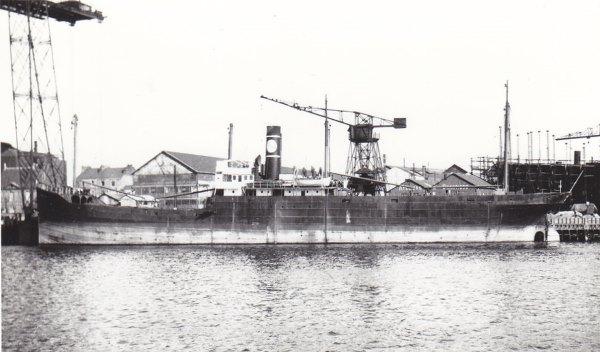Henri Mory
British Steam merchant

| Name | Henri Mory | ||
| Type: | Steam merchant | ||
| Tonnage | 2,564 tons | ||
| Completed | 1921 - Ateliers & Chantiers de Bretagne, Nantes | ||
| Owner | H. Gonneville Ltd, Cardiff | ||
| Homeport | Swansea | ||
| Date of attack | 27 Apr 1941 | Nationality: | |
| Fate | Sunk by U-110 (Fritz-Julius Lemp) | ||
| Position | 54° 00'N, 19° 00'W - Grid AL 68 | ||
| Complement | 32 (28 dead and 4 survivors). | ||
| Convoy | |||
| Route | Pepel - Freetown (21 Mar) - Bermuda (9 Apr) - Barrow-in-Furness | ||
| Cargo | 3150 tons of manganese ore | ||
| History | Launched as Les Hurlus, completed in March 1921 as Thorium for Anciens Etablissements Charles Le Borgne, Marseilles. 1922 sold to Société Industrielle de Combustibles, Nantes. 1926 renamed Martine for Union Industrielle et Maritime (SA de Nav Les Armateurs Français), Rouen. 1932 renamed Henri Mory for Société Française d'Armement Union Industrielle et Maritime, Rouen. In July 1940, the Henri Mory was seized at Swansea by Britain and transferred to the Ministry of War Transport (MoWT). | ||
| Notes on event | At 01.30 hours on 27 April 1941 the unescorted Henri Mory (Master Joseph Havard) was hit on the starboard side in the after end of the engine room by one torpedo from U-110 while steaming on a non-evasive course at 4 knots in fine and clear weather about 330 miles west-northwest of Blasket Islands, Ireland. The ship had been dispersed from convoy SL-68 on 21 March, went to Bermuda and then proceeded independently to the UK because the vessel was too slow to join a transatlantic convoy, barely able to make 6 knots and later further reduced due to troubles with its boiler tubes. The crew of 30 men and two gunners (the ship was armed with two 90mm and three machine guns) began to abandon ship in the lifeboats, but had difficulties to so in the very dark night and a heavy swell caused the port lifeboat to drift away unoccupied. Henri Mory sank in less than four minutes and only a few survivors managed to escape the suction of the sinking ship. The master, 25 crew members and two gunners were lost. The port lifeboat was boarded by the cook and he was soon thereafter joined by the chief officer, who was exhausted from swimming to it and could only get aboard after 20 minutes. In the meantime, the U-boat picked up a Russian sailor who clung to wreckage from the upper bridge and subsequently went alongside the lifeboat. The Germans asked the chief officer the usual questions about the name of the ship, cargo and routing and then transferred the rescued man to the boat with a bottle of cognac. He had been interrogated while aboard, given a good drink of cognac and two packs of cigarettes. However, the Germans somehow misidentified the ship as André Moyrand. When U-110 left the area at about 02.00 hours the commander shouted: Goodbye, you will be picked up shortly. Tell Winston Churchill there is a war on. Despite the sea anchor and attempts to keep the head to the wind with oars and sails, the lifeboat was riding the easterly swell beam on until daylight as the occupants were all exhausted. No more survivors were found at the sinking position, but in the afternoon a raft with one man aboard was seen about a mile away. Until darkness they attempted to reach the raft but this was prevented by the heavy swell and lack of strength of the three survivors. The lifeboat was circled twice by a British Catalina flying boat in the morning of 29 April and the next day a corvette was seen about four miles away, but the chief officer and the two crew members were eventually picked up by HMS Hurricane (H 06) (LtCdr H.C. Simms, RN) in position 54°01N/17°17W at 15.45 hours and landed at Gourock in the evening of 1 May. The survivor on the raft was rescued after eight days by the British steam merchant Lycaon. | ||
| On board | We have details of 30 people who were on board. | ||
If you can help us with any additional information on this vessel then please contact us.
